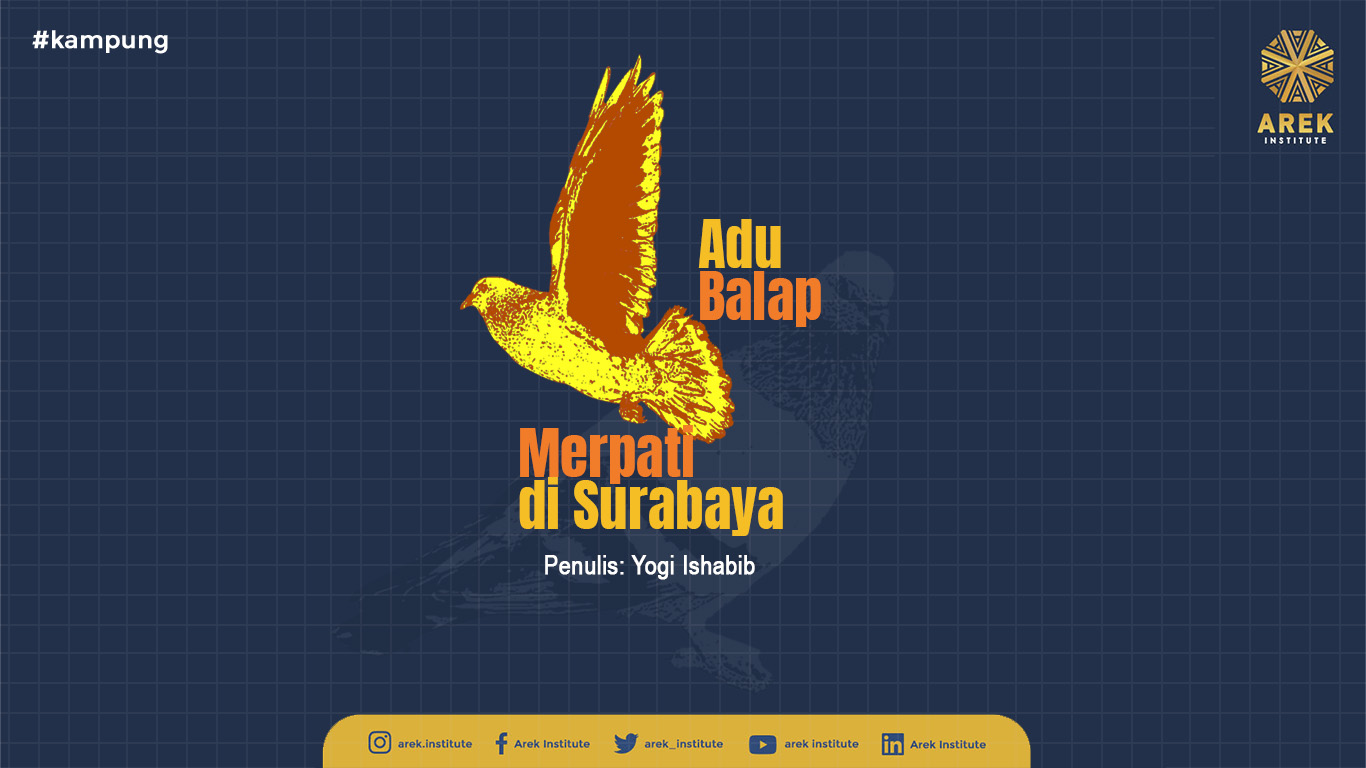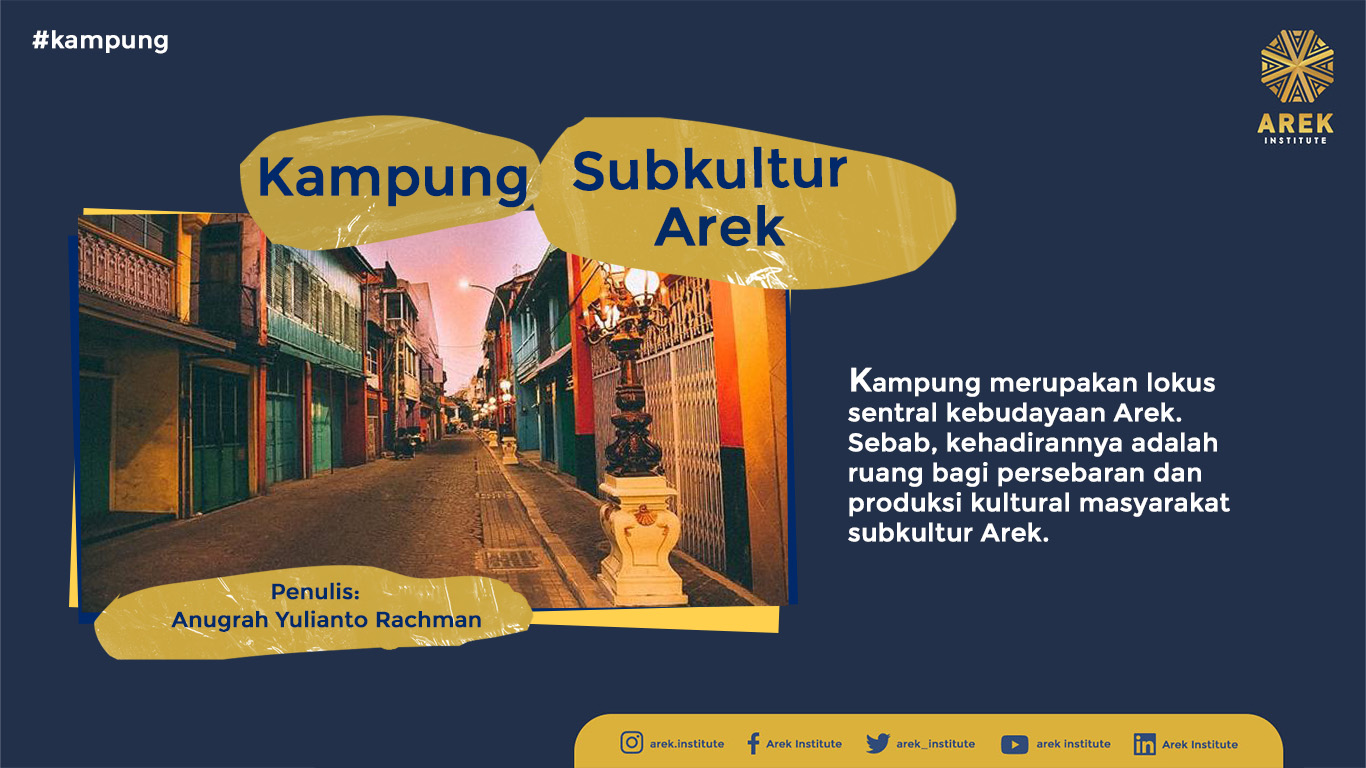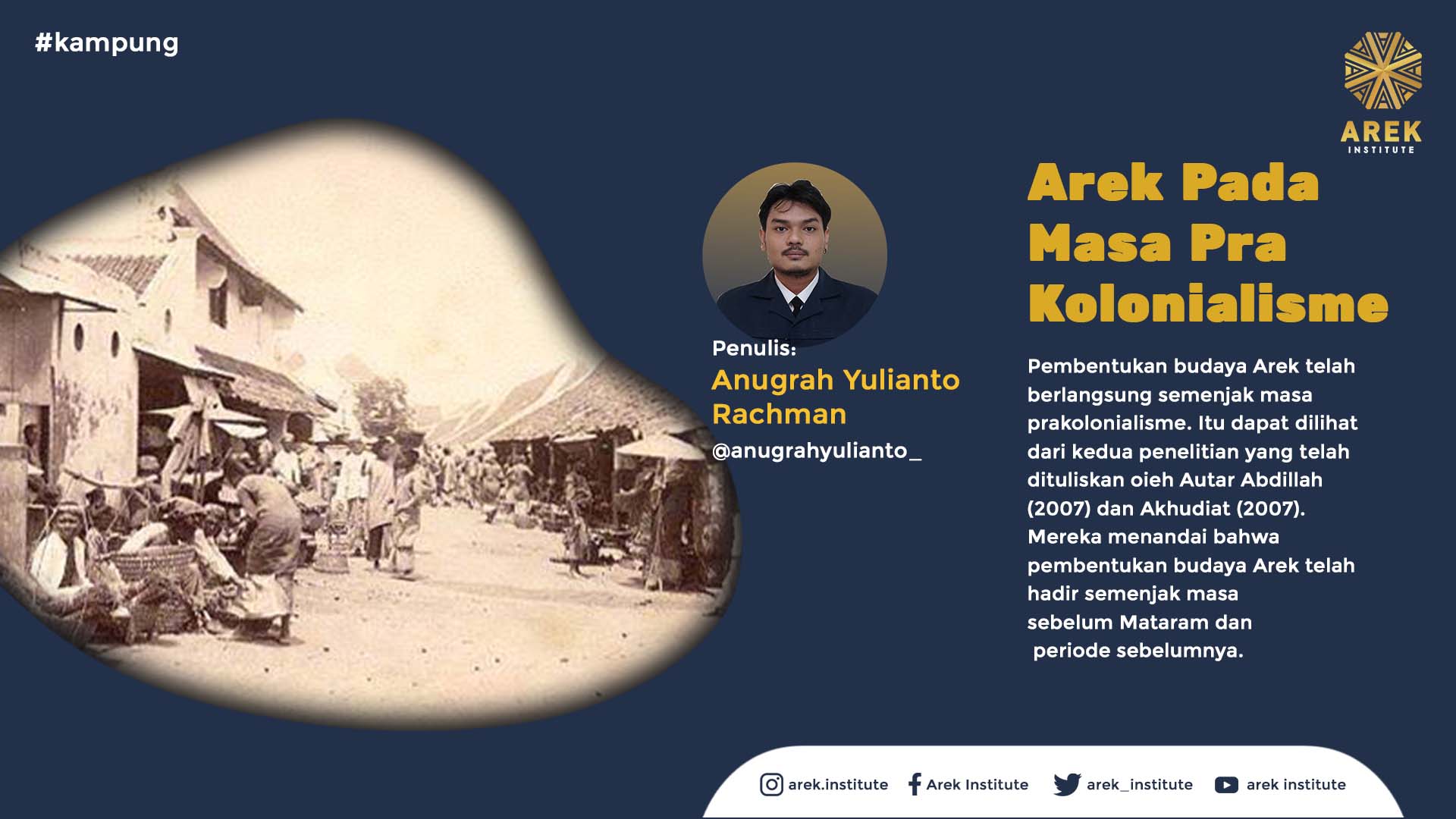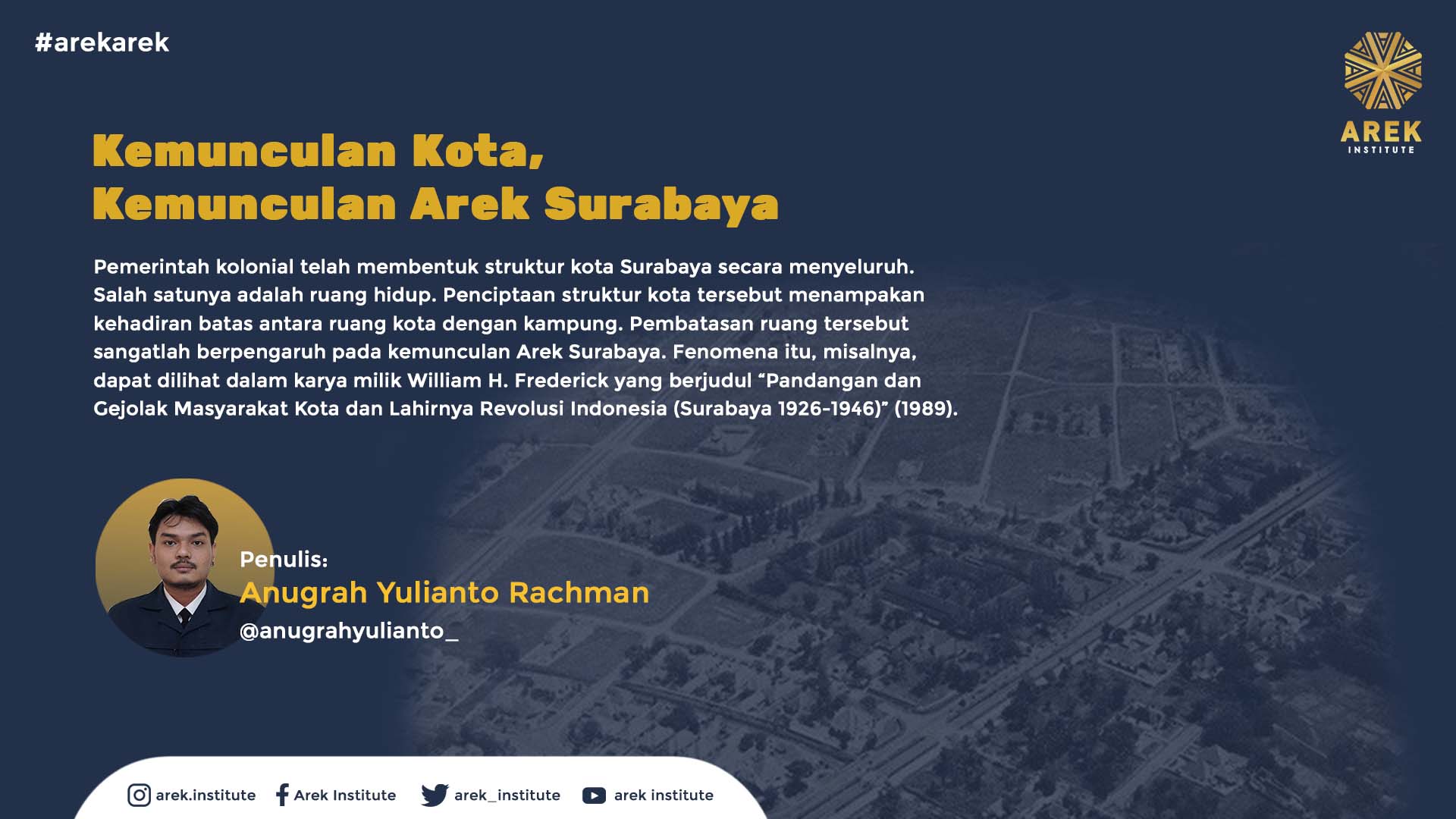This is the republished article from the book “Surabaya: City Within Kampung Universe” by Yogi Ishabib.
“Husy, You put too much belief in anything Dutch.
A Javanese knight requires five:
a house, a woman, a horse, a kukila and a suspicion.
Can you remember all these?”[1]
The above quote is taken from the conversation between Mother and Child—the two main characters in the most famous love story written by an Indonesian literature giant, Pramoedya Ananta Toer. In the story, what Mother tried to say to Minke, her son, was that he should not see an era only from the Western (European) perspective with all its modern achievement, but also from looking back to the concept of wise and noble men which is taken from the essence of a cultural life of the place where he has lived and been raised in: the land of Java.
The Javanese have a very unique way to explain how a person may become a real Javanese or what they call Satria Jawa (a Javanese knight). The person must know himself, his environment, and his purpose in life. There are five requirements to become Satria Jawa and they are: wisma (a house), wanita (a woman/a wife/a life partner), turangga (a horse/a ride/a means to achieve his goals), kukila (a bird/a pet/a hobby), and curiga (an alertness/a weapon). Interestingly, to become a real Javanese, a person does not necessarily have to have all serious things since the Javanese version of wise and noble men also allows flexibility in the form of klangenan[2] matters.
The question is why are birds (kukila) used as the metaphor for hobbies/interest? There might be many reasons for this, but I will try to find the answer in Jangka Jayabaya?[3] or Jayabaya’s ancient prophecy which says that a bird is used as the metaphor since it is a creature that flies free and perches on a tree only to fly away again hopping from one tree to another. This is a metaphor for a human who is free to choose their hobby. The bird (kukila) was also used by Jayabaya as the mark of an era—an era when nothing is certain (kala kukila).[4] This uncertainty is the ship crew which helps us ride the high and low tide of moral behaviors when responding to the activities based on our hobby so that this hobby becomes a culture with all its limitation. For this, I would like to discuss the pigeon race[5] as a strong cultural rite in Surabaya. The journey of this cultural rite until today faces various reactions and uncertain attitudes according to the era and the moral of the law. It is very interesting to discuss the pigeon races since it shows the complexity of the meaning of kukila: its denotative meaning i.e. a bird, an activity which involves a hobby (klangenan), and the mark of an era.
Kukila as a Bird
In the 1945 – 1950 War of Independence Album, there was a photo published by Republic of Indonesia’s Publishing Agency. It was the photo of a stuffed homing pigeon named “Letnan” (lieutenant). The note below the photo says, “Due to its skillfulness and intelligence, this homing pigeon was able to connect one Indonesian Armed Force post to another in the war zone.”[6]
This legendary pigeon was from the wartime Rongglawe Lamongan/Bojonegoro commando area with Surabaya as its: front in 1946. During the war, a few NICA-Dutch army officers saw a pigeon flying aimlessly going up and down as if it were about to die. The pigeon was in fact dying since it had lost both its wings shot deliberately to end its life. While covered in blood, the bird, the brave homing pigeon, carried an important message for the Indonesia’s Armed Forces about the situation in the war zone and the enemy’s secret. The story is that it died right in front of the designated commander of Indonesia’s Armed Forces, but successfully brought the message. After the heroic incident, the body of the pigeon was given a military honour and immortalized in the museum with a military rank of lieutenant (posthumous) and since then, the pigeon was named “Lieutenant”.
The story of the Lieutenant has the same heroic level as a few other legendary homing pigeons at wartime such as Cher Ami and Gl Joe. The stories about pigeons carrying important messages at the beginning of the modern war seem paradoxical. Unlike the pigeon, the information technology which man tried to achieve at that time did not have the functional flexibility especially if the technology was destroyed by the war. From World War I until World War II, a quarter of a million homing pigeons were used a message carrier.[7]
Stories about the usefulness of pigeons to carry messages were actually based on their strengths: cruise power, strong memory, navigational skill, communication, and accompanied with the long history of its relationship with humans.[8] Pigeons were one of the first few animals domesticated by humans. The type of pigeons domesticated was believed to be the rock doves/pigeons (Columba livia)[9] and as the result of the domestication, 300 other species of pigeons which belong to the family of Columbidae and the order of Columbiformes were born. Up to the modern era, pigeons or doves have had the most variations and derivative characteristics of all types of birds in the world.[10] Initially done to turn them into a food source, the birds have gone through various stages to increase its abilities and skills in speed for a race and in memory for carrying messages. Until today, pigeon breeding is still practiced by humans for a few purposes: race and homing (sports), meat (utility), and display (fancy).[11]
Domestication done by humans over pigeons is one significant achievement in human civilization since as a result, human’s life changes. Pigeons might not be as fast as alap-alap[12] feared and worshipped by farmers in a Javanese agricultural society, nor as noisy as birds such as bulbuls, shamas, passerines, robins, nor as clever and annoying as the crows. It is clear that messages will be delivered without the legs of the pigeons and no applauses from people below will be given without pigeons flying fast to its home – a style and a manoeuvre which becomes the perfect inspiration for the pioneers in the world of aviation.
Kukila as a Klangenan (Hobby)
Since its first recorded domestication during the Mesopotamia civilization in 5000 BCE, pigeons had had various roles in many cultures and civilizations. A traditional narration in a few world cultures considered the domestication as the superiority of humans over all worldly creatures by stating that humans have the privilege to conquer everything on earth according to their wills and needs. Subsequently, these superior humans saw the need to domesticate the pigeons due to their functions, characteristics, and advantages. A few traditional narrations also state that the domestication is a symbol of humans’ conquest to fulfil their desire to build a civilization.
Aesop, a legendary fable author who is believed to live in the ancient Greece period (620-564 BE), wrote an interesting metaphor for the domestication of the pigeons as humans’ means to build their culture and civilization through their conquest over other creatures. In Aesop’s collection of fables, there are two stories with pigeons as the characters. First, pigeons are described as a figure that represents all good things and due to this, they deserve to live free. The story starts with the kindness of the pigeon that helps an ant which accidentally falls into a river and the ant is dragged deeper by the river’s strong current. Kindness is paid in return when the ant rescues the pigeon from a hunter.
The ant bites the hunter’s eye when the hunter is aiming his gun at the pigeon. The pigeon manages to escape and is able to fly freely to safety.[13] Second, pigeons are described as the symbol of the heart’s sincerity and purity and due to this, they are caught by humans’ desire to keep them. This story starts with a pigeon who feels happy, loved and secured as a human pet. The pigeon is also waiting for its chicks to hatch. Suddenly, in flies a pitch-black crow which is considered the exact opposite of beauty. The crow is perching inside the pigeon’s beautiful cage while listening to the pigeon boasting about all the good things she is getting today and the happiness she will get once her chick hatch. The crow smiles and says, “My good friends, cease from this unseasonable boasting. The larger the number of your family, the greater your cause of sorrow, in seeing them shut up in this prison-house.”[14]
In Indonesia, there are many pigeon-related expressions whose meanings might contradict each other. The expression “merpati tak pernah ingkar janji” (pigeons never break their promise) is just one among many such expressions which mean loyalty since the pigeons are willing to fly tens or hundreds of kilometers to return to their nests and spouses. In contrast, the expression “bagai merpati di dalam sangkar” like a pigeon in a cage depict it is kept (domesticated) by humans – the people who put shackles on the pigeon. There are other expressions which represent a paradox such as “inak-jinak merpati” (as tame as a pigeon) and explain that each subject has its own paradox; a pigeon can be tame (as a result of domestication), but at any time, it can fly without ever returning (chasing freedom or the exact opposite of “loyal” – a word that is previously associated with the pigeons). The variety of responses to the pigeons with all its characteristics, depictions, and functions the duality of good-evil, glory-shame, sanctity-profanity, or the thin line between them.
This thin line has the same context as kukila as a klangenan. For humans to become a whole Javanese, humans need some spaces-spaces for life choices so that they don’t deprive themselves of worldly pleasure to bow down to the seriousness of the world order. This Javanese space concept is interesting to discuss since it allows humans to possess the time, not to be conquered by it. Kukila as a klangenan is the thin line between the serious world which mandates an unending series of activities to fulfil the liquid worldly needs and the world that allows its inhabitants to take joy in the fulfilment of their heart’s desires which in this case is the pigeon race.[15]
The thrill of a pigeon race usually comes from the speed and the brilliant manoeuvre done by the pigeons when flying back to pegupon. [16] This thrill was cleverly captured by a famous Indonesian writer, Suparto Brata. In his novel titled Mencari Sarang Angin, Suparto Brata specifically mentioned the pigeon race in Surabaya in one of the settings. The race was said to drown its fans in happiness until “He discussed the matters enthusiastically while imitating the way the pigeon flew with his fingers, making two ‘thuk’ sounds close to each other. It was a beautiful conversation”.[17]
Some pigeon racing enthusiasts were able to differentiate pigeons with certain breeding lines. The superior breeding line in the pigeon race is commonly referred to as trah jawara or the champion dynasty. The superior breeding line can be read through its physical characteristics called katuranggan.[18]
A few commented that coming from trah jawara does not always guarantee a pigeon will win a race especially when it does not receive a good care. However, having trah jawara will ease the selection process and the special care for the pigeons that will participate in the race.
The story of the pigeon race thrill reminded me of a legendary name born out of a race held by the oldest pigeon race club in Indonesia. The pigeon’s name was Si Pecut (The Whip) and it was the winner of the super derby class for 1,000 km distance. The pigeon successfully completed the race in three days with the speed of 650 meter per minute.[19] Si Pecut, however, is not the only legend around. The pigeon that belonged to Yett Resdianto successfully crossed four straits (Flores, Sumbawa, Lombok, and Bali Strait) with a total distance of 1600 km in 1988. The pigeon with a ring number P-87-870560 conquered the harsh mountainous weather and the storm in the strait in just four days faster than its competitor, an American pigeon, which completed it in one week.
The two races were held by Lang-Lang Buana; the oldest pigeon race club in Indonesia. Lang-Lang Buana began as a pigeon racing community created by the members of the military force and Dutch merchants who kept these birds (as pets) and turned them into racers. The community who had the Dutch and the Eurasians as its members and was led by Meneer Kransier was named Akbar Khan.[20] After the independence, many members of the community returned to the Netherland and the pigeons that once belonged to the members were sold to Indonesians. Along with the changes of the pigeon ownership and the change of membership, the club’s name was also changed into Lang-Lang Buana.
Lang-Lang Buana became the first official pigeon race club in Indonesia led by Major General Rubiyono Kertopati. In 1962 Lang-Lang Buana participated in many national and international sporting events such as Ganefo (Games of the New Emerging Forces) in Jakarta, Asian Games, and National Sports Week (Pekan Olahraga Nasional/PON). Until today, Lang-Lang Buana is still active involved in pigeon races and holds pigeon racing events in the international calendar of PIPA (Pigeon Paradise)—a Belgian-based racing pigeon auction house—and all over the worlds. Recently Lang-Lang Buana held a Derby-class pigeon race with a distance of 600 km in Blitar, East Java on 26 August 2017.
Meanwhile in Surabaya, the last recorded official pigeon race event was the National Championship of Pigeon Race Anniversary Cup Ill held on 22 August 2003 in Sukolilo.[21] The championship was held by Persatuan Penggemar Merpati Balap Sprint Indonesia (PPMBSI), a fan-based pigeon racing association, which hoped that the event could be included in the national agenda and in the PON. Unfortunately, after the event, the pigeon race was not included in any national-scale sporting events. However, this does not deter the community’s enthusiasm to hold pigeon races in their local areas. Consequently, not accepted among the national-scale events, the pigeon race becomes stigmatized as a marginal activity which does not deserve to be discussed in a public domain based on one-sided moral principles.
The pigeon race seen as a marginal culture which represents a negative expression is nothing new. However, linking it to a moral issue will not help to undo the tangled web that accompanies its activities. On one side, the pigeon race is tightly wrapped in long cultural values just like any speed-related races. On the other, the pigeon race just like any sport-related races is vulnerable to the tight grip of showbiz which is constantly associated with glamour and its negative connotation, among which is gambling. This is why it is important to provide an access to information, literature, and their supporting facilities in reading cultural changes according to the context of the era. People should wrap themselves in the negative perception of klangenan activities such as the pigeon race. Since the beginning, the meaning of kukila (bird) as a klangenan (hobby) provides choices for humans to own the time, not be owned by it. If this type of klangenan does take up so much of its fan’s time and take away their everyday life until they fall into a bottomless pit of sadness, this activity can no longer be called a klangenan.
Kukila as a Mark of an Era
There was a brave man who had the audacity to criticize the Japanese colonial government. He was depicted as a typical Indonesian unarmed military hero, not an aristocratic hotshot General nor an Islamic clerk igniting the spirit of jihad. He was Gondo Durasim, an artist born out of common poor people, who travelled around to perform a play through the art of Ludruk or an East Java’s comedy show. He pioneered the show in 1931 and became a top-notch entertainer among the common people at this difficult time. Dr. Soetomo used Gondo Durasim’s influential show to raise people’s awareness of the oppression done the colonial government and to stress the importance of unity among the people and sovereignty of Indonesia as a country free from the shackle of the colonization.[22]
Gondo Durasim, later known as Cak Durasim, continued to make satires about the colonial government and the kidung jula-juli[23] or East Javanese traditional songs in each show he performed. The climax was when the Japanese government officials heard the comedic song and were furious when they learned the meaning of the song. The legendary song says, “Pegupon omahe doro, melu Nippon tambah soro” which means pegupon, the house of the pigeons, became more miserable when conquered by the Japanese. Cak Durasim was arrested by the Japanese colonial government in 1943 dan died in 1944.[24]
Keeping pigeons (doro in Javanese language) in pegupon is one part of the pigeon racing culture in Surabaya[25], and this culture was quoted by legendary artists such as Cak Durasim as a symbol of the struggle against the colonial government. The Ludruk shows typically performed a satire of everyday events sung in the form of kidung jula-juli. This indicates that the pigeon race has become a common culture since the colonial era. After Indonesia’s independence, the pigeon race became a trend for the Surabayans either through established pigeon racing clubs such as Lang-Lang Buana or as a pastime for the working class.[26] In Surabaya, the working class raced their pigeons in the afternoon after work by using public spaces such as the intersections of the road, open fields, train tracks, and graveyards. The pigeon racers who used the city landscape were referred to as the kenthongan.
The trend of pigeon racing post-independence did not last long and people began to consider it as an unacceptable part of culture. In 1965, suspected by the military as a means of communication used by the communists to overthrow the government, pigeon races were banned and all activities related to it were also banned. Even pigeon racing clubs led by military personels such as Lang-Lang Buana became the subjects of an investigation. Also, to train the flight skills and speed of the pigeons, the owners had to request a permission and obtain an approval from the transportation affair office.[27] Since then, pigeon races have been thought as an activity done by the uneducated and low-income marginal people and the abangan (the orthodox Javanese), and considered as a gambling event and often as a communist culture.
Paradoxically, the incumbent Mayor of Surabaya, Colonel Sukotjo requested a license to the Minister of Social Affairs to legalize Lotto (Lotere Totalisator) for Surabaya 9 October 1967. On 15 May 1968, a Decree No. B. A. 5-4-44/71 was issued by the central government through the Minister of Social Affairs to officially hold the Lotto program fund the 8th National Sport Week (PON) in Surabaya.[28] By legalizing Lotto, the government indirectly legalized gambling and the gambling activities once again flourished in Surabaya. Subsequently, another controversy emerged when comparing legalized gambling done by the government and illegal gambling done out of habits. The pigeon race in this case is unique since this activity does not belong to any of the abovementioned gambling. Government Regulation Number 9 Year 1981 mentions types of gambling, and they are:
- “The types and forms of gambling held in Casinos include, among others, Roulette, Blackjack, Baccarat, Creps, Keno, Tombola, Super Ping-Pong, Lotto Fair, Satan, Bakyu, Jackpot, Ji Si Kie, Big Six Wheel, Chuck a Luck, arrows or hen’s feathers throwing to rotating targets, Pachinko, Poker, Twenty-One, Hwa-Hwe, Kiu-Kiu;
- The types and forms of gambling held in gathering places include arrows or hen’s feathers throwing to rotating targets, ring throwing, coin throwing, Kim, fishing hooks, shooting non-rotating targets, ball throwing, cock fighting, cow fighting, buffalo fighting, goat fighting, horse racing, cow racing, dog racing, Hailai; Mahyong’ erek-erek;
- The types and forms of gambling related to habits include cock fighting; cow fighting; buffalo fighting; horse racing; cow racing; goat fighting.[29]
Moreover, Article 303 Verse (3) the Penal Code states that:
- By a maximum imprisonment of two years and eight months or a maximum fine of six thousand rupiahs shall be punished by any person who without being entitled thereto:
1st, performs as his trade the intentional offering or providing of opportunity for a game of chance, or intentionally participates in an undertaking thereto;
2nd-ly, intentionally offers or gives the public an opportunity to a game of chance, or intentionally participates in an undertaking thereto, irrespective whether or not the use of said opportunity is made dependent on a condition or on the observance of some or other form;
3rd-ly, participates in a game of chance as his trade.
- If the offender commits the crime in his profession, he may be deprived of the exercise of said profession.
- Game of chance includes each game whereby in general the chance of gain depends on chance, even if that chance increase by more training or by greater dexterity of the player. It shall include all chance agreements on the outcome of contest or other games that are not concluded among those who take part therein, as also all bets.[30]
Although two regulations, i.e. the Government Regulation No.9/1981, Article 303 Verse 3 and the Penal Code, do not state that the pigeon race is classified as gambling, the law enforcement may easily categorize it as one form of gambling which needs to be eradicated at any time. The perpetrators may be caught, brought to court, and sentenced to jail for gambling. Pigeon racers’ arrests and the confiscation of pigeons and their pegupons can be read all over the news and the latest one was made by the police in Karang Asem, Surabaya on 2 August 2017.[31] The police sucessfully caught 40 perpetrators suspected of conducting various forms of gambling: pigeon racing, cock fight, games of chance, and dice games and they were charged with gambling with a maximum sentence of five-month jail terms if proven guilty by the court to commit “unlicensed gambling”. [32]
The opinion on pigeon race’s relation to gambling is not shared by everybody. In 1998, Police Major General M. Dayat, the Head of the East Java Regional Police, defended the practice by saying that pigeon racing was one important culture for the working class since it was the main source of income for the unemployed. He insisted that the pigeon race needed to continue as a part of culture although at the same time the waves of anti-gambling protests coming from a group known as Forum 99 Ulama were pushing the government to ban all gambling practices in East Java.[33] He explained that the pigeon race had the potentials to be developed for tourism, employment, and any economic opportunities derived from the pigeon racing events. Based on this belief, Police Major General M. Dayat held a Police Cup tournament in 1998 to attract tourist, to increase the community’s economic activities, and to control illegal pigeon racing activities which might still exist in kampung areas.[34] After this tournament, there has hardly been any other pigeon racing events held by the police force and nowadays, there is only one pigeon racing event facilitated by the Indonesian police force which is the Kapolres Cup Klaten tournament held between 9-11 June 2017 in Mlese Village, Gantiwarno Sub-district, Klaten District.[35]
The pigeon race has always been a controversy since it was believed to be many things: a prestigious sporting event, a symbol of resistance to the colonialism, a communism method, until an activity with a negative connotation such as gambling – all of which only tell us that the pigeon race has always been regarded as the mark of an era. It is as if it were the mark of each historical journey which became the living witness ready to be branded with anything associated with an era. I deliberately borrowed the term From Jangka Jayabaya about the concept of kala kukila, an era when nothing is certain. The pigeon race clearly has all the right requirements for uncertainty as it is the mark of turbulent time and blurriness of our conventional limitations against all oppositional perspectives: good-evil, glory-shame, legal-illegal and sanctity-profanity. The pigeon race is always present not only as a culture and an identity, but also as a text that always haunts the legal moral narration which intersects with the cultural narration like pigeons which are released by the kenthongan boys only to fly back to their cages as a winner or a loser or even not to return at all flying freely to any place they wish.
[1] Pramoedya Ananta Toer. Bumi Manusia. Jakarta: Hasta Mitra. 1980. p 463
[2] (Jawa) Klangenan: something that you like, hobbies, interest
[3] Andjar Any. Jayabaya, Ranggawarsita, dan Sabda Palon. Semarang: Aneka lImu. 1976
[4] Ibid p. 81
[5] In Surabaya, it is commonly reffered to as adu doro
[6] M.F. Mukthi. Legiun Merpati untuk Komunikasi. Historia magazine dated Friday, 3 May 2013. Can be accessed in http://historia.id/modern/legiun-merpati-untuk-komunikasi
[7] Pigeons in War: The Royal Pigeon Racing Association. Can be accessed in http://www.rpra org/pigeon-histo-ry/pigeons-in-war/
[8] M. Thomas P. Gilbert and Michael D. Saphir (Ed Claire Smith). Pigeon: Domestication in Encyclopedia of Global Archeology. New York: Springer. 2014. p.2
[9] Ibid. Henceforth referred to as “pigeon” in English which means doves derived from the latin “pipio” which means young bird. Pigeons are normally used by the English-speaking people to refer to the doves.
[10] T. D Price. Domesticated Birds as a Model for The Genetics of Speciation by Sexual Selection. Genetica 116:311-27. 2002
[11] History of Pigeon. Animal Science Journal No. 4H135. University of Wisconsin: 4-H Publication 2004. p.9
[12] A type of falcon – a nickname for a bird of prey from the family of Falconidae
[13] Aesop’s Fables. Shanghai: Comercial Press. 1922. p.6
[14] Ibid. p. 131
[15] Similar to the concept of pastime by the working class (a similar meaning to masculinity) in Europe. The use of pastime concept of klangenan is not an absolute monolithic concept owned by the Javanese culture. Further reading can be found in Martin Johnes article. Pigeon, Racing, and Working-Class Culture in Britain. 1870-1950. Cultural and Social History Vol. 4. Issue 3. P. 361-383.
[16] A cage/a house. In a few regions in Surabaya, it is also called bekupon
[17] Suparto Brata. Mencari Sarang Angin. Jakarta: Grasindo. P. 116
In the nove, Suparto Brata mentioned the names of places commonoly used for pigeon racing in Surabaya such as Kedungdoro, Embong Malang, Tegalsari, and Kedungsari. These are the names of major roads surrounding Kampung Plemahan area which became the setting of the novel.
[18] Katuranggan in champion pigeon racer dynasty generally discusses the physical specifications the weight, the posture, the shape, and upper part of the wings, the size of the head, the eyes, the legs, the shape and size of the beak, the chest bones, and the tail. The complete article can be read in Agrobis Burung Tabloid No. 767, third week of February 2015 edition.
[19] Inilah Merpati Pemenang Adu Cepat Bali-Jakarta. Koran Tempo. Thursday, 10 October
[20] Lang-Lang Buana: Komunitas Merpati Tertua Indonesia. Tempo Newspaper. Friday, 8 March 2013 can be accessed in https://m.tempo.co/read/news/2013/03/08/108465911/lang-lang-buana-komunitas-merpati-tertua-indonesia
[21] Surabaya Menggelar Lomba Balap Merpati. Liputan6 SCTV, 23 August 2003, 09.10 WIB
[22] Partisipasi Seniman dalam Perjuangan di Propinsi Jawa Timur: Studi Kasus Kota Surabaya tahun 1945-1949. Jakarta: Departemen Pendidikan Kebudayaan RI. 1999 p. 31-37.
[23] The East Javanese art of rhyming. The Form is similar to Malay’s with rhymes at the end of each line.
[24] Cak Durasim sang the song in a ludruk show in Mojorojo Village, Jombang. This was Cak Durasim’s last performance.
[25] A pegupon (a pigeon’s house) is the easiest way to differentiate racing pigeons and pigeons as pets. Pegupon is a large vertical wooden hut which can house a few pigeons and also function as the finish line during pigeon racing.
[26] Purnawan Basunodoro. Et al. (ed). Tempo Doeloe Selaloe Aktoeal. Jogjakarta: Ar Ruzz Media. 2007. P. 156
[27] An interview with Karna Tjendera with Tempo Newspaper. Lang-Lang Buana, Komunitas Merpati Tertua Indonesia. Tempo Newspaper. Loc cit
[28] Initially, the program was known as Lotto Jatim, but DPR-GR disapproved the program throughout all East Java. The only city that was allowed to continue with the program was Surabaya based on the Governor Decree on 4 April 1968 No. Gub/76/78. Data can be accessed in Surabaya Archive No. Definitif 909 The government Regulations Number 9 Year 1981. National Archive Collection, Archive Number 1536
[29] The Government Regulation Number 9 Year 1981. National Archive Collection, Archive Number 1536
[30] The Penal Code Weboek van Strafrecht Staatsblad) Number 732 Year 1915
[31] Dibiarkan Polsek Tambaksari, Arena Judi Merpati Jl. Karang Asem diobrak Polrestabes Surabaya can be accessed in http://www.lensaindonesia.com/2017/08/02/dibiarkan-polsek -tambaksari-arena-judi-merpati-jl-karang-asem-diobrak-polrestabes-surabaya.html
[32] I took an example of court ruling Number: 872/Pid.B/2012/PN.Jr. which was given to a pedicab driver who were arrested and brought to court for pigeon racing gambling which can be seen in the Supreme Court Ruling Directory of the Republic of Indonesia in putusan.mahkamahagung.go.id
[33] Robbie Peters. Surabaya, 1945-2010 Neighbourhood, State and Economy in Indonesia’s City of Struggle Singapore: NUS Press. 2013. P. 131
[34] Ibid. p. 132
[35] Kapolres Cup Klaten Digeruduk Merpati Balap Luar Kota, Acara Puncak Minggu 11 Juni can be accessed in http://burungnews.com/sragen-september-cerita-sragen-bc-agenda708.html?542






0 Comments